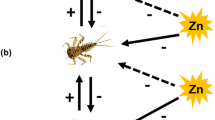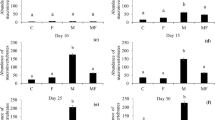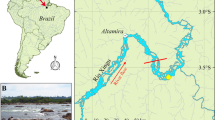Abstract
Freshwater marshes are often subject to severe disturbance from seasonal drying (dry-downs) and frequently have distinct food webs relative to other freshwater systems. Subtropical marshes in the Florida Everglades have a unique trophic structure characterized by low nutrients, high standing stocks of algae in the form of floating and benthic periphyton mats, low standing stocks of primary and secondary consumers (omnivorous small fishes, tadpoles, and large macroinvertebrates), and very low standing stocks of tertiary consumers (large fishes). To account for this trophic structure, two hypotheses have been proposed: 1) high algal standing stocks result from top-down control over omnivores (small fishes, tadpoles, and macroinvertebrates) by large fishes, or 2) that the physical and biotic structure of periphyton mats impedes grazing. We conducted caging experiments before and after the dry season to delineate interactions among species influencing trophic structure in these marshes. Treatments included a refuge cage that was accessible to omnivores but excluded large fishes, an open cage accessible by omnivores and large fishes, and an omnivore exclusion cage designed to exclude fishes, tadpoles, and large macroinvertebrates. The physical and biotic structure of mature periphyton mats mediated direct and indirect interactions of omnivores and large fishes. More omnivores used the refuge treatment compared to the open treatment, likely to avoid large fishes, leading to a trophic cascade where abundance of epiphytic algae was reduced. Reductions in epiphytic algae were especially pronounced after the dry season when neonate sailfin molly were the dominant omnivore. We did not find comparable reductions of periphyton-mat biomass in the refuge treatment, suggesting that edible forms within these mats gain an associative refuge from grazers. Reduced grazing on edible algae in mature periphyton mats may explain the high standing stocks of algae characteristic of Everglades marshes.
Similar content being viewed by others
Literature Cited
Angeler, D. G., M. A. Rodrigo, S. Sanchez-Carrillo, and M. Alvarez-Cobelas. 2002. Effects of hydrologically confined fishes on bacterioplankton and autotrophic picoplankton in a semiarid marsh. Aquatic Microbial Ecology 29: 307–12.
Batzer, D. P. 1998. Trophic interactions among detritus, benthic midges, and predatory fish in a freshwater marsh. Ecology 79: 1688–98.
Batzer, D. P., C. R. Pusateri, and R. Vetter. 2000. Impacts of fish predation on marsh invertebrates: direct and indirect effects. Wetlands 20: 307–12.
Browder, J. A., P. J. Gleason, and D. R. Swift. 1994. Periphyton in the Everglades: spatial variation, environmental correlates, and ecological implications. p. 379–418. In S. M. Davis and J. C. Ogden (eds.) Everglades: The Ecosystem and its Restoration. St. Lucie Press, Boca Raton, FL, USA.
Carpenter, S. R., J. F. Kitchell, and J. R. Hodgson. 1985. Cascading trophic interactions and lake primary productivity. BioScience 35: 634–39.
Carpenter, S. R., J. F. Kitchell, J. R. Hodgson, P. A. Cochran, J. J. Elser, M. M. Elser, D. M. Lodge, D. Kretchmer, X. He, and C. N. von Ende. 1987. Regulation of lake primary productivity by food web structure. Ecology 68: 1863–76.
Chick, J. H. and C. C. McIvor. 1994. Patterns in the abundance and composition of fishes among beds of different macrophytes: viewing a littoral zone as a landscape. Canadian Journal of Fisheries and Aquatic Sciences 51: 2873–82.
Chick, J. H. and C. C. McIvor. 1997. Habitat selection by three littoral zone fishes: effects of predation pressure, plant density and macrophyte type. Ecology of Freshwater Fish 6: 27–35.
Chick, J. H., C. R. Ruetz, and J. C. Trexler. 2004. Spatial scale and abundance patterns of large fish communities in freshwater marshes of the Florida Everglades. Wetlands 24: 652–64.
Chick, J. H. and M. J. Van Den Avyle. 1999. Zooplankton variability and larval striped bass foraging: evaluating potential match/mismatch regulation. Ecological Applications 9: 320–34.
Clarke, K. R. and R. M. Warwick. 1994. Change in Marine Communities: An Approach to Statistical Analysis and Interpretation. Plymouth Marine Laboratories, Bournemouth, UK.
DeAngelis, D. L., J. C. Trexler, and W. F. Loftus. 2005. Life history trade-offs and community dynamics of small fishes in a seasonally pulsed wetland. Canadian Journal of Fisheries and Aquatic Sciences 62: 781–90.
Donar, C. M., K. W. Condon, M. Gantar, and E. E. Gaiser. 2004. A new technique for examining the physical structure of Everglades floating periphyton mat. Nova Hedwigia 78: 107–19.
Dorn, N. J., J. C. Trexler, and E. E. Gaiser. 2006. Exploring the role of large predators in marsh food webs: evidence for a behaviorally mediated trophic cascade. Hydrobiologia 569: 375–86.
Eaton, A. D., L. S. Clesceri, and A. E. Greenberg. 1995. Standard Methods for the Examination of Water and Wastewater, nineteenth edition. American Public Health Association, Washington DC, USA.
Gaff, H., J. H. Chick, J. C. Trexler, D. DeAngelis, L. Gross, and R. Salinas. 2004. Evaluation of and insights from ALFISH: a spatially explicit, landscape-level simulation of fish populations in the Everglades. Hydrobiologia 520: 73–87.
Gaiser, E. E., J. J. Scinto, J. H. Richards, D. L. Childers, D. L. Childers, J. C. Trexler, and R. D. Jones. 2004. Phosphorus in periphyton mats provides the best metric for detecting low-level P enrichment in an oligotrophic wetland. Water Research 38: 507–16.
Gaiser, E. E., J. C. Trexler, J. H. Richards, D. L. Childers, D. Lee, A. L. Edwards, L. J. Scinto, K. Jayachandran, G. B. Noe, and R. D. Jones. 2005. Cascading ecological effects of low-level phosphorus enrichment in the Florida Everglades. Journal of Environmental Quality 34: 717–23.
Geddes, P. and J. C. Trexler. 2003. Uncoupling of omnivoremediated positive and negative effects on periphyton mats. Oecologia 136: 585–95.
Harvell, C. D. 1990. The ecology and evolution of inducible defenses. Quarterly Review of Biology 65: 323–40.
Heck, K. L. J. and L. B. Crowder. 1991. Habitat structure and predator-prey interactions in vegetated aquatic systems. p. 281–99. In S. S. Bell, E. D. McCoy, and H. R. Mushinsky (eds.) Habitat Structure: The Physical Arrangement of Objects in Space. Chapman and Hall, London, UK.
Hunt, B. P. 1952. Food relationships between Florida spotted gar and other organisms in the Tamiami Canal, Dade County, Florida. Transactions of the American Fisheries Society 82: 13–33.
Jordan, F. 1996. Spatial ecology of decapods and fishes in a northern Everglades wetland mosaic. Ph.D. Dissertation. University of Florida, Gainesville, FL, USA.
Kushlan, J. A. 1974. Effects of a natural fish kill on the water quality, plankton, and fish populations of a pond in the Big Cypress Swamp, Florida. Transactions of the American Fisheries Society 103: 235–43.
Kushlan, J. A. 1976. Environmental stability and fish community diversity. Ecology 57: 821–25.
Layman, C. A. and K. O. Winemiller. 2004. Size-based responses of prey to piscivore exclusions in a species-rich neotropical stream. Ecology 85: 1311–20.
Leibold, M. A., J. M. Chase, J. B. Shurin, and A. L. Downing. 1997. Species turnover and the regulation of trophic structure. Annual Review of Ecology and Systematics 28: 467–94.
Light, S. S. and J. W. Dineen. 1994. Water control in the Everglades: a historical perspective. p. 47–84. In S. M. Davis and J. C. Ogden (eds.) Everglades: The Ecosystem and its Restoration. St. Lucie Press, Boca Raton, FL, USA.
Lima, S. L. 1998. Nonlethal effects in the ecology of predatorprey interactions. BioScience 48: 25–34.
Loftus, W. F. 2000. Accumulation and fate of mercury in an Everglades aquatic food web. Ph.D. Dissertation. Florida International University, Miami, FL, USA.
Loftus, W. F. and A. M. Eklund. 1994. Long-term dynamics of an Everglades small fish assemblage. p. 461–83. In S. M. Davis and J. C. Ogden (eds.) Everglades: The Ecosystem and its Restoration. St. Lucie Press, Boca Raton, FL, USA.
Loftus, W. F. and J. A. Kushlan. 1987. Freshwater fishes of southern Florida. Bulletin of the Florida Museum of Natural History 31: 147–344.
McCormick, P. V., M. B. O’Dell, R. B. E. Shuford, J. G. Backus, and W. C. Kennedy. 2001. Periphyton responses to experimental phosphorus enrichment in a subtropical. Aquatic Botany 71: 119–39.
Moore, J. C., E. L. Berlow, D. C. Coleman, P. C. de Ruiter, Q. Dong, A. Hastings, N. C. Johnson, K. S. McCann, K. Melville, P. J. Morin, K. Nadelhoffer, A. D. Rosemond, D. M. Post, J. L. Sabo, K. M. Scow, M. J. Vanni, and D. H. Wall. 2004. Detritus, trophic dynamics and biodiversity. Ecology Letters 7: 584–600.
Nelson, C. M. and W. F. Loftus. 1996. Fish communities of alligator ponds in the high water period of 1983–1985, and 1994–1996. p. 89–101. In T. V. Armentano (ed.) Proceedings of the Conference: Ecological Asessment of the 1994–1995 High Water Conditions in the Southern Everglades. South Florida Management and Coordination Working Group, West Palm Beach, FL, USA.
Osenberg, C. W. and G. G. Mittelbach. 1996. The relative importance of resource limitation and predator limitation in food chains. p. 134–48. In G. A. Polis and K. O. Winemiller (eds.) Food Webs: Integration of Patterns and Dynamics. Chapman & Hall, London, UK.
Osenberg, C. W., O. Sarnelle, and S. D. Cooper. 1997. Effect size in ecological experiments: the application of biological models in meta-analysis. American Naturalist 150: 798–812.
Polis, G. A. and D. R. Strong. 1996. Food web complexity and community dynamics. American Naturalist 147: 813–46.
Porter, K. G. 1977. The plant-animal interface in freshwater ecosystems. American Scientist 65: 159–70.
Ruetz, C. R. III, J. C. Trexler, F. Jordan, W. F. Loftus, and S. A. Perry. 2005. Population dynamics of wetland fishes: spatiotemporal patterns shaped by hydrological disturbance? Journal of Animal Ecology 74: 322–32.
Schmitz, O. J., V. Krivan, and O. Ovadia. 2004. Trophic cascades: the primacy of trait-mediated indirect interactions. Ecology Letters 7: 153–63.
Sutela, T. and A. Huusko. 2000. Varying resistance of Zooplankton prey to digestion: implications for quantifying larval fish diets. Transactions of the American Fisheries Society 129: 545–51.
Trexler, J. C., W. F. Loftus, F. Jordan, J. H. Chick, K. L. Kandl, T. C. McElroy, and O. L. Bass, Jr. 2002. Ecological scale and its implications for freshwater fishes in the Florida Everglades. p. 153–81. In J. W. Porter and K. G. Porter (eds.) The Florida Everglades, Florida Bay, and Coral Reefs of the Florida Keys: An Ecosystem Sourcebook. CRC Press, New York, NY, USA.
Trexler, J. C., W. F. Loftus, and S. Perry. 2005. Disturbance frequency and community structure in a twenty-five year intervention study. Oecologia 145: 140–52.
Trussell, G. C., P. J. Ewanchuk, and M. D. Bertness. 2002. Field evidence of trait-mediated indirect interactions in a rocky intertidal food web. Ecology Letters 5: 241–45.
Turner, A. M. and J. C. Trexler. 1997. Sampling aquatic invertebrates from marshes — evaluating the options. Journal of the North American Benthological Society 16: 694–709.
Turner, A. M., J. C. Trexler, C. F. Jordan, S. J. Slack, P. Geddes, J. H. Chick, and W. F. Loftus. 1999. Targeting ecosystem features for conservation: standing crop in the Florida Everglades. Conservation Biology 13: 898–911.
Van Meter-Kasanof, N. 1973. Ecology of the microalgae of the Florida Everglades. Part I. environment and some aspects of freshwater periphyton, 1959 to 1963. Nova Hedwigia 24: 619–64.
Warfe, D. M. and L. A. Barmuta. 2004. Habitat structural complexity mediates the foraging success of multiple predator species. Oecologia 141: 171–78.
Werner, E. E. and S. D. Peacor. 2006. A review of trait-mediated indirect interactions in ecological communities. Ecology 84: 1083–1100.
Author information
Authors and Affiliations
Corresponding author
Rights and permissions
About this article
Cite this article
Chick, J.H., Geddes, P. & Trexler, J.C. Periphyton mat structure mediates trophic interactions in a subtropical marsh. Wetlands 28, 378–389 (2008). https://doi.org/10.1672/07-121.1
Received:
Accepted:
Issue Date:
DOI: https://doi.org/10.1672/07-121.1




